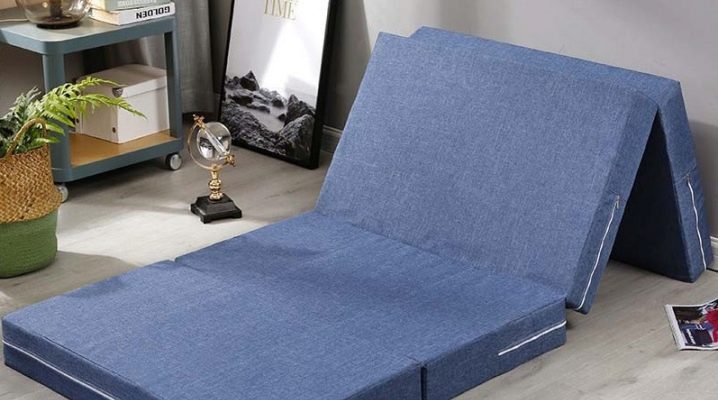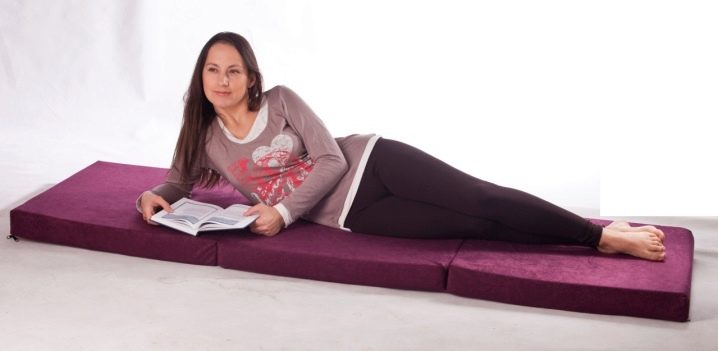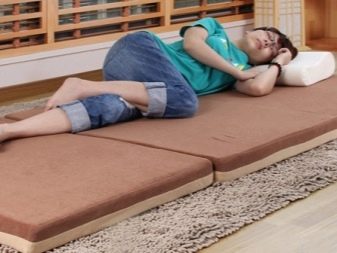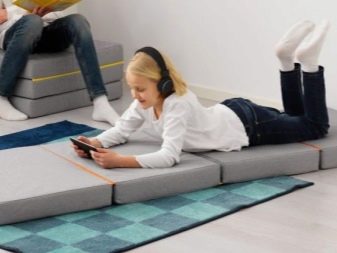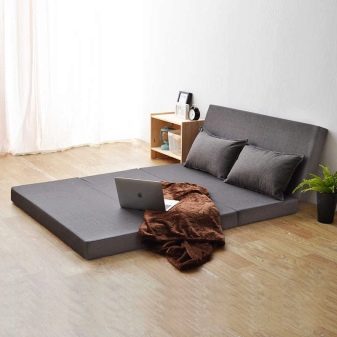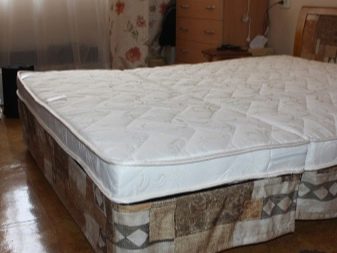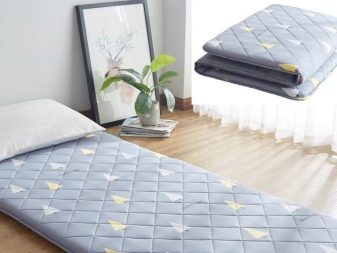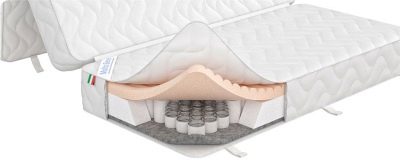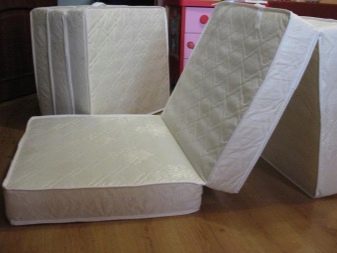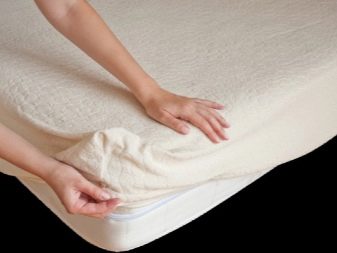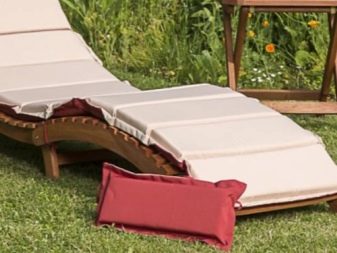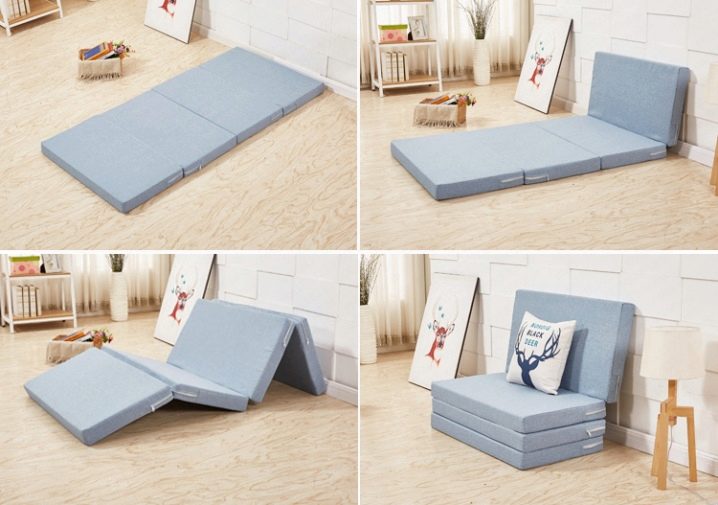All about folding mattresses on the floor
Folding beds and inflatable mattresses are not the most comfortable options for sleeping. The best alternative to a bed is a folding mattress on the floor. It is much more comfortable and healthier for the spine.
Advantages and disadvantages
A folding mattress on the floor consists of several separate sections connected by a fabric cover. Most often the mattress consists of 3 blocks, but there can be up to 10 of them.
The more sections, the more expensive the product.
When unfolded, the transforming mattress is no different from its classic counterpart. It is just as comfortable to sleep on.
Moreover, if there are problems with the spine, such a bed can be recommended for medical reasons.
Manufacturers produce orthopedic models with increased rigidity. If there is a problem with free space, then such a mattress will be an excellent alternative to a bed. It requires less space and can be easily folded and stowed away in a closet or other storage during the day. It will perfectly fit into the interior of the oriental style; minimalists will like it.
A number of other advantages can be distinguished:
- light weight, no problems with transportation;
- mobility;
- versatility;
- practicality;
- when folded takes up little space, compact storage;
- the design is easy to assemble;
- will organically fit into any interior;
- cheaper than a bed;
- creating a resting place on almost any surface.
A folding mattress is an excellent alternative to an inflatable mattress if you need to quickly organize a sleeping place, for example, for guests. When folded, it takes up more space, but is not afraid of sharp objects and is not deflated overnight, more comfortable for the back.
The service life is much longer.
The height of the product is such that it is impossible to fall from it. This is especially true for children who constantly toss and turn in their sleep. But there is also a drawback here. It is more difficult to climb from it than from the bed, so it is not suitable for older people.
If desired, the transforming mattress can be lifted onto pallets, a podium, a folding bed, or used as a regular mattress on a bed.
Probably the only significant disadvantage of a floor mattress is concrete floors and drafts. If you sleep on the floor, you can seriously catch a cold in a draft during the cold season.
In this case, you will have to additionally attend to the insulation of the floors or raise the berth.
The floors themselves must always be kept clean and washed daily. And you can also note the lack of storage systems that are found in frame furniture. Therefore, it is necessary to organize additional storage space for bedding. The bedding itself will have to be washed more often.
Description of species
Floor mattresses are usually divided into futons and fold-out transformers. Unlike conventional mattresses, futons have a harder bottom layer that adheres to the floor, and additional pads to prevent slipping.
Sectional mattresses can be divided into two large groups: spring and springless (foam). Spring mattresses are heavier because they have metal springs. They can be independent, located in separate blocks or like the Bonnel system. The latter is considered an outdated technology, because the springs are located in one row and are interconnected, which is not very comfortable for sleeping. This technology is used only for the production of economy class products.
Such a mattress is not recommended for constant sleep, but it is a good option for additional space for guests.
Springless mattresses are made of foam materials. They are natural and artificial. They are lighter and thinner than spring ones. Latex, polyurethane foam or coconut coir are used as fillers.
Artificial latex is most often used - it is cheaper, but natural rubber is also found. Does not cause allergies, does not absorb moisture and various odors, has increased elasticity.
The density and elasticity of polyurethane foam mattresses depend on the production technology, the degree of foaming. Therefore, such a mattress has a different degree of firmness. Lightweight, durable.
The only drawback is that it absorbs moisture.
Coconut coir is made from coconut fleece treated with latex. Gives high rigidity, therefore it is not used in its pure form, only in combination with latex or polyurethane foam.
Selection Tips
Mattresses have varying degrees of firmness. Soft ones are more suitable for pregnant women and the elderly. For those who have back problems or whose body weight is more than 90 kg, rigid orthopedic options are recommended, the rest are medium-rigid.
In case of scoliosis, it is better to choose springless rigid models, with intervertebral hernia - also on foam, but medium-hard. For osteochondrosis, a medium-hard version with independent springs is recommended, and for rheumatism, arthritis or arthrosis - with separate spring blocks.
If you do not need to clean the mattress every morning, it is better to choose tall models with a thickness of 20-25 cm. In other cases, focus on storage possibilities - the thinner the berth, the less space it will take. Lightweight mattresses can slip on slippery floors.
If the sleeper is constantly spinning, it is better to pay attention to heavier models with a thick flooring layer.
The cover protects the mattress from dirt and abrasion and provides additional comfort. The thicker it is, the softer the surface.
Use cases
The main purpose of the floor mattress is to be used instead of a bed. According to its characteristics, it may well replace frame furniture. Moisture-resistant models can be taken outdoors. They can replace a chaise longue, an air mattress in a tent, or simply provide a comfortable sleep in a simple country house.
Its light weight makes it easy to take with you.
Some designs can be converted into a small sofa or armchair. This is especially in demand for small apartments. One item can perform the functions of several at once. Even an ordinary folded three-section mattress can be used as a soft pouf.
